The Legacy of Fukushima Sensei (7th Dan)
by Yosh Nakano
Asian American & Pacific Islander Month
Sensei Tsuruo Fukushima (May 25, 1924- May 12, 2006)
I was born and raised in the “Village” of Okinawa. Tsuruo Fukushima was a member of the U.S Civil Service as was my father that worked and lived as part of the “Village” that provided support for the U.S. military mission on the island, “The Keystone of the Pacific”. In the evenings he trained kids from elementary school to high school in judo at his dojo in Camp Kue. No one in our “Village” has been a mentor and Sensei to more kids than Fukushima Sensei. He along with his assistant instructors Captain Harai and Sergeant De Costa developed many kids both physically and mentally while building character over the span of 2 decades.
The “Village”
Okinawa is the largest island of the Ryukyu Islands which stretch from Kyushu to Taiwan. It is only 70 miles long and 10 miles at its widest point. It means different things to different people. For many tourists from mainland Japan, China and Southeast Asia, it is a popular destination with miles of white sandy beaches and beautiful coral reef for scuba diving.
For my classmates and schoolmates, it’s a nostalgic place where they spent their adolescence and formed lifetime friends and bonds. For me it is a unique community that was the “Village”, that provided me with a stable albeit naïve environment for me to enjoy my formative years. Most of these kids were born on Okinawa and didn’t leave until graduating from high school, primarily Kubasaki. It’s our hometown that now only exists in our memories.
On April 1, 1945, the future of the Okinawans was very bleak. The U.S. Tenth Army launched the largest amphibious landing in the Battle of Okinawa. It was to be the fiercest and bloodiest battle of the Pacific Theater as the next target was Mainland Japan. Over 12,000 allied troops perished. Over 100,000 Japanese soldiers were killed or committed suicide. Only 8,000 surrendered. Out of a local population of 300,000, over 100,000 Okinawans died. Estimates have been as high at 147,000.
Most of the mothers in our “Village” were part of the survivors of that horrific battle. My mother, although Uchinanchu escaped the battle living in Saipan but returned to Okinawa after the war. For the most part our fathers were Nisei’s recruited primarily from Hawaii shortly after the war. The majority worked as U.S. Federal civil servants as part of the Department of Army Civilians (DAC). They supported the U.S. military presence on Okinawa ranging from post engineers to logistics to property disposal. A separate but certainly a part of our “Village” was FBIS. They were primarily Koreans or Chinese, but I didn’t differentiate them from other Asians. All I knew was that these kids as a group were very smart.
A major part of any “Village” are the teachers, not just the ones in school but in the Boy Scouts and in sports. The teacher that had the most impact on me was Darwin Scales who taught 8th grade Current Events. Along with the red-headed girl, they started to reexamine my thinking. It was a shock to me that there were two points of view on any topic. She and I were always on opposite sides, and I thought she was a radical. I now realize she was ahead of my time. Miss Regina Piencikowski taught Calculus which were supposed to be the top students in our Senior class with the exception of Alex Hwang who was a junior. I was clearly out of my element.
My coaches helped build my character and competitiveness. Coach Ray showed his compassion when he cut me when I tried out for the Sukiran Cavaliers football team in the 9th grade. I was dejected all night but when he called me early the next morning to tell me he had found 4 uniforms for those he had cut, the sky turned blue again. Coaches Lindsey, Beverly, and Hilgers continued to help me develop and instill confidence. When I tried out for the Sukiran Knights Varsity in my senior year, I hoped I would make the team. Not only did I make the team, but I also became a starter. I thought nothing could be greater until I was named on the Kubasaki All-Star Team. I still find it incredulous given all the good athletes in our school. Coach Bruce Derr and Richard Saddlemire were exceptional in their methodical approach to coaching. Somewhere along my development in sports I adopted Vince Lombardi’s quote “Winners never quit; quitters never win” as my motto. This would later prove to be detrimental to my career as a professional poker player as I could almost never quit when losing. As important and as good as these teachers were, due to the nature of the military policy of minimizing long-term relationships, there was no continuity.
Mr. Fukushima
In the summer of 1971, I took a summer class in judo. It was in a small Quonset hut near where I lived in Camp Kue. After I completed the class, I heard that there was a judo dojo nearby. Before moving to Kue, we lived in Kishaba far from where most of our community lived. The dojo had initially been in Camp Mercy and most of the families that lived there were aware of the dojo and had started their kids there when they were pikinini’s, Hawaiian for small kids.
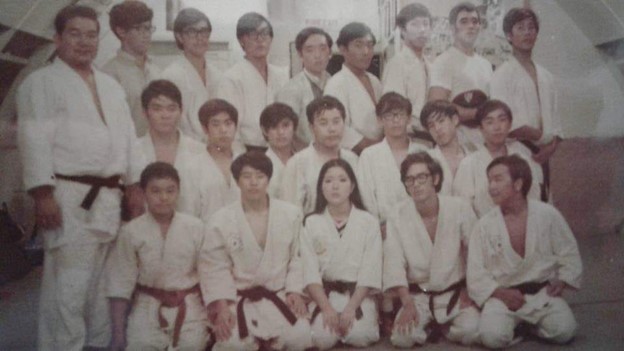
Fukushima Sensei at Dojo in Camp Mercy 1968.
I had gone to K-9 and the Mercy gang went to Portwheel 9. United at Kubasaki as sophomores, I only knew the Mercy kids by reputation. In our neighborhood we made bamboo flutes that would shoot paper wads. I had heard the Mercy gang used 22 calibers bullets fashioned out of bamboo and turned them into zip guns. I learned later that was Urban legend, but they did have JD’s over there that would steal hubcaps. To me it seemed like a very rough neighborhood.
I don’t remember when I initially met Mr. Fukushima, which is what everyone else called him as well, but I remember being in awe of the black belts- the Nakasone twins, Illa Wi, Andy Andow and Bobby Moniz. There were many other black belts that had recently left the club due to a conflict with becoming “Born Again Christians”. It was clearly a disruption to Sensei’s program. During the football season, I would go to judo on Monday, Wednesday, and Friday after football practice and a light dinner. Mr. Fukushima wanted me to come to judo on Tuesdays and Thursdays when the pikinini’s trained and I tried it one night, but it was too much. He was very demanding not only during practice but tried to get us to practice additional nights and Saturday mornings. Sensei’s Captain Harai and Sergeant DeCosta were no less demanding. If you were in grimacing in pain, Captain Harai would say “I don’t feel nutting”. I heard him say that on many other occasions, but I never gave him the satisfaction of saying it to me again.
Mr. Fukushima was dedicated to judo and his students. He was at the dojo 6 days a week. As evidenced by the Facebook page ‘I Took Judo with on Okinawa with Sensei Tsuruo Fukushima’ his influence over the kids spanned over decades even to those who did not stay in the program. Terry and Kenny Keller in the late 60’s went to play judo at Florida State University.
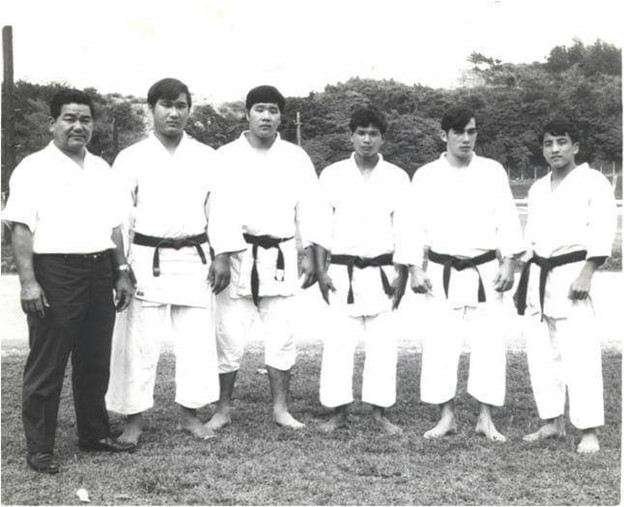
Sensei Fukushima with his team in 1968. Kenny Keller is 5th from right. His older brother Terry was already attending Florida State.
In the 70’s the superstars were Keith and Burt Nakasone. They decided they didn’t want to compete against each other in college so only Keith went to San Jose University to train under Yosh Uchida, a judo legend. Keith became ranked #8 in Black Belt magazine. He won numerous amateur events and was the captain of the 1980 US Olympic Judo Team. It broke everyone’s heart that President Carter decided to boycott the event but none more than his father’s who wrote many letters to the White House. Mr. Nakasone was the ultimate judo parent. His sons were natural athletes and would have excelled in any sport. They were only allowed to play judo until their senior year. He relented and let Keith play varsity basketball that year.
Also, in the early 70’s there was a pikinini named Kevin Asano. He moved to Hawaii at a young age where he continued his training. When Sensei retired from the civil service and opened the Leeward Judo Club in 1981, Kevin rejoined his initial Sensei. He also trained under Coach Uchida at San Jose State University. He won the bronze at the 1987 World Championships in Essen, West Germany. At the Seoul Olympics in 1988, he won the silver. Kevin has since had many honors bestowed upon him. https://leewardjudoclub.com/Instructors.aspx.
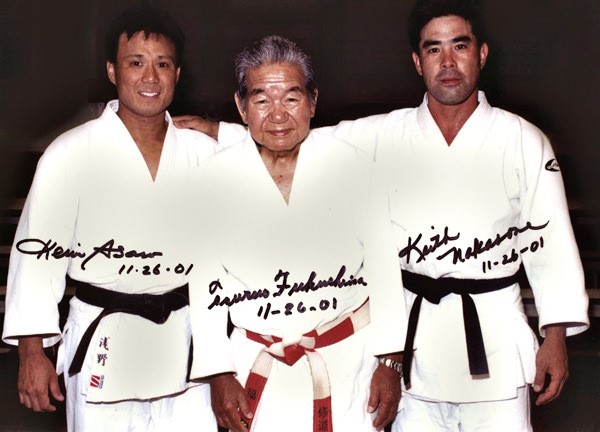
One day he set up a rondori session (tournament style practice) at the Okinawa Koko Dojo in Naha. This high school along with Okinawa Conan Koko finished in the top two in the annual high school championships. If that wasn’t bad enough, it was worse. The local Okinawans did not have the benefit of a washer/dryer in their homes. They just hung their gi’s up to dry after practice. Their gi’s smelled and were very slimy from the build-up of dried sweat. It was the most miserable practice session I have ever been through, and my teammates felt no different. Driving us home, he pulled up to the A&W and treated us to ice cream. He smiled delightfully as he watched us enjoy our cones taking away the memories of the torturous night. As stern as he was in practice, Mr. Fukushima had a soft side to him.
Judo Tours
Mr. Fukushima would arrange a judo tour of Mainland Japan. To raise funds, he would hold a luau and the dojo would sell kalua pork. Everyone pitched in. I happened to be a passenger when we stopped by the beach where they were cooking kalua pork. Apparently, you dig a pit, burn wood into charcoal and lay banana leaves under the pig and slow cook it. I saw the Nakasone brothers along with adults shirtless and sweaty working around the pit. It looked like a lot of hard, dirty work to me, so I just stayed in the car.
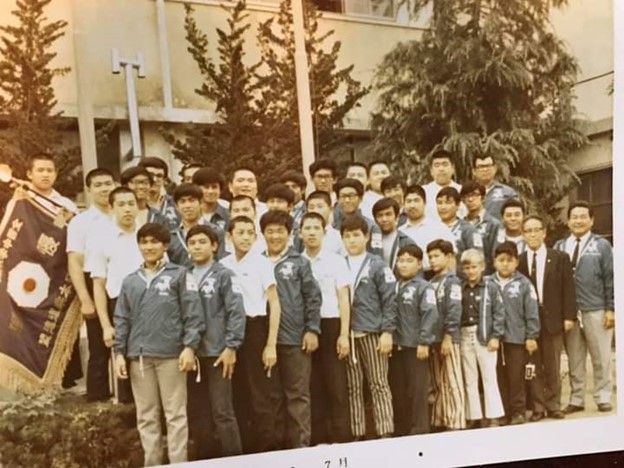
Japan Tour Judo Team Summer 1971
In the summer of 1972, I was on the judo tour. We took a passenger ship and ran into a typhoon, so our ship had to shelter in a harbor until the storm passed. Since many of the black belts had left the dojo, Ken Kimura was the lone black belt on this trip. It was an adventurous and educational trip. After we finally reached port, we traveled north by bus through the mountainous central part of Honshu, Japan’s central island. We would go sightseeing and at the judo stops, we would have a tournament and have group dinners. In one small town in the mountains, there was only chopsticks, no forks or knives. I had no choice but to finally learn how to use them.
One of the most impressive high schools was Tenri Koko. The huge dojo had over 100 black belts. When Mr. Fukushima announced that we were going to have a tournament, I thought that was crazy since we were all brown belts except for one. My opponent’s specialty seemed to be the choke. Fortunately, I had trained with Andy Ando who was an expert and I managed to evade getting choked out by him in a tournament. I was able to evade him as well, but it was a hellish 5 minutes. I felt a sense of accomplishment with a draw. After the tournament was over, we were now to rondori (live sparring) for 30 minutes. I saw my opponent going over to a sempai, bowing his head and getting a reprimand with a rap on the head with his knuckles from him. That was not a good sign for me, and sure enough he made a beeline toward me and said onegaishimasu which means “please” prior to engaging in a match. Usually during rondori, you change opponents every 5 minutes. This didn’t happen. I had to defend myself against an angry opponent determined to choke me out. If I thought the tournament had been hellish, this seemed like an eternity. I was so relieved to hear tomare (stop).
The U.S. High School Nationals
Mr. Fukushima took a team to the 1973 High School Nationals in Los Angeles. We didn’t have weight classes in Okinawa, and he put me in the 165 lb. to avoid having me play Burt in the 135 lb. class. In Okinawa I may have a chance with someone bigger and heavier because they may not be very good. However, this was the National Championship, and they were good, bigger, and stronger. I had no chance. That night I was rooming with Mr. Fukushima. I didn’t know anyone could snore so loud. I could not sleep nor get any peace even with covering my ears tightly with my hands. The snoring was piercing. I went to a teammates room and slept on a quiet floor. The next morning, he kept saying he saw the window was open and he thought I had jumped out because I had lost that day. He seemed like he was genuinely worried.
The following year we went to Chicago which had a chill factor that made it below freezing . Mr. Fukushima had learned, and we all competed in our respective weight classes. I fared much better and if had won my final match, I would have won my round robin. The Dumapay brothers both medaled showing their skill. Ray was big but Mikey was a very good natural athlete. Along with Fred Freed and Tommy Yamamoto, they had won the 1972 Okinawa Jr. High School Championship.
Mike and Ray Dumapay appear the cover of This Week ON OKINAWA after placing 2nd and 3rd in their respective weight classes along with Tsuruo Fukushima Sensei. Ray was always smiling and gregarious. Mikey was very quiet. They were both very humble and polite. You would never know they were both great athletes from their demeanors.
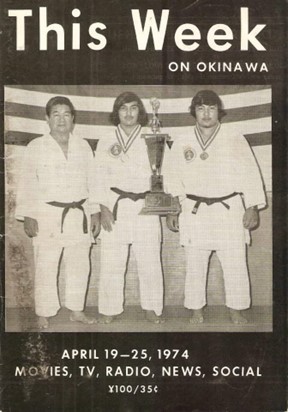
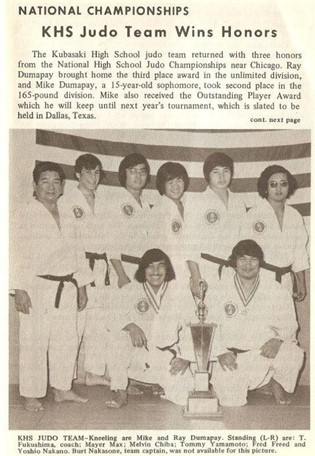
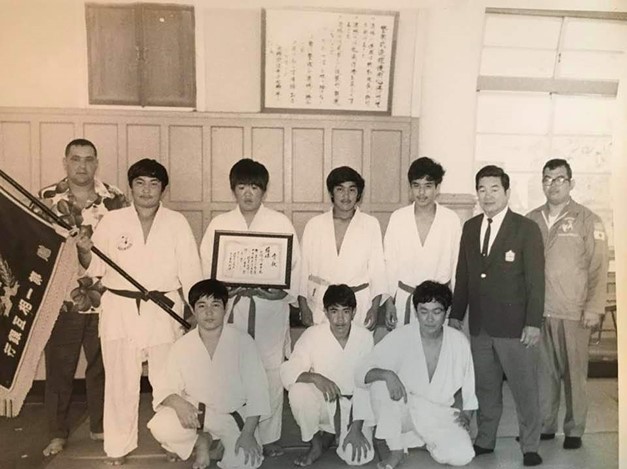
Sensei’s Sgt. De Costa, Fukushima, & Capt. Harai with the 1972 Okinawa Jr. High School Champions.
The Okinawa High School Championship
David vs. Goliath: Keith Nakasone vs. Ganeko
by Yosh Nakano in collaboration with Mel Chiba and Meyer Max
It’s spring of 1974 and time for the annual Okinawa High School Judo Championship Tournament at the Naha Police Gym. The perennial champions are either between powerhouses Okinawa Koko or Konan Koko (Koko translates to high school). The format is a five-man team match with the winning team advancing. There are no weight classes. In the previous year, we finished 3rd.
Okinawa Koko is a public school, and their players have their hair buzz cut. Konan Koko is a private school, known for their elite sports program and have long hair similar to ours. We are a mixture of Okinawan and Filipino Americans representing Kubasaki High School Judo Team, a DOD school.
Depending on the draw, we would be eliminated by either one of the powerhouses. This year, we met Konan in the semi-finals. The undefeated captain of Konan is massive. Ganeko weighs 400 lbs. in a 6’ frame. To put that into perspective, I tried to walk past a 450 lb. Doyle Brunson once and he bumped me with his belly. I felt like I had walked into a brick wall as he gave me a knowing smile at the look of shock on my face. If Ganeko doesn’t throw his opponent, his weight brings them to the mat and then it’s all over. His opponent is powerless to escape.
Our team is not too shabby. The Nakasone twins are world-class athletes that had trained in Kumamoto with Yasuhiro Yamashita who won 5 gold medals in international competitions including the 1984 Olympic Gold in Los Angeles. Ray and Mikey Dumapay placed 3rd and 2nd respectively in the U.S. High School National Championships. Mel Chiba and I were the weakest and rotated in the matches.
In this match, I was 1st up. My opponent was tall and slender. I have 2 go-to techniques. My throw is the morote seoi nage (1) Seoi-nage – Basic principles – YouTube. The one most often seen on the screen is the ippon seoi-nage. My best foot technique is the kouchi gari (1) kouchi gari – YouTube. I immediately faked the morote and as he braced back, I caught his lead foot with the kouchi. He went down on his back and since this was the 1st time, I had accomplished this move this quickly, I now proceeded to go into a chokehold until I saw the referee out of the corner of my eye have his armed raised signaling an ippon or winner. I was surprised but I would take it.
When it comes down to the 5th and final match, we are tied. It is now Keith against the enormous Ganeko. Keith is 5’6” and 135 lbs. It is a mismatch. Keith’s eyes are steely with his entire focus on his huge opponent. Ganeko reaches out with his right arm, but Keith grabs the sleeve tightly preventing him from getting a grip. Ganeko now tries to grab Keith with his left arm, but Keith fends it off while he keeps tugging on Ganeko’s lead sleeve and moving from left to right. He knows if Ganeko should get a grip, he is finished. As Keith keeps moving left and right fending off Ganeko’s outstretched arm, he also moves back trying to get him off balance. After a couple of minutes, Ganeko looks like he’s had enough of the parrying and plants his right leg. Keith now pulls hard with his grip on Ganeko’s right sleeve, and he instinctively pulls back. Keith seizes the opening and moves in with a kouchi on his lead right foot. With his foundation removed, Ganeko’s weight sends him falling back. He’s able to turn his body so he lands on his side, but the inconceivable has happened. The referee puts his right arm straight out to his side and firmly announces wazari or half-point. On the sidelines, we all jumped up and cheered. What had been apprehension and hope was replaced by pure excitement. Now Keith was ahead and now he could win. It wasn’t going to be easy. Ganeko became much more aggressive as he tried to grab Keith with his left arm, but Keith stayed with his same strategy fending off his arm and pulling from left to right. We kept yelling and shouting encouragement and after what seemed like an eternity, jikan (time) was called.
It is one of the most historic and greatest matches ever played, especially since competition is now held with weight classes.
We lost in the finals to Okinawa Koko, but we were ecstatic about finally reaching the finals. After the tournament, the Konan Koko sensei lined up his team on the mat in view of the entire gym and slapped each player hard on the face after which they bowed and apologized. We all felt bad about that but that was not unexpected.
The next year and the following year, the KHS Judo Team won the High School Championships. Ray and Mikey Dumapay, Fred Freed and Tommy Yamamoto had grown up to be studs!
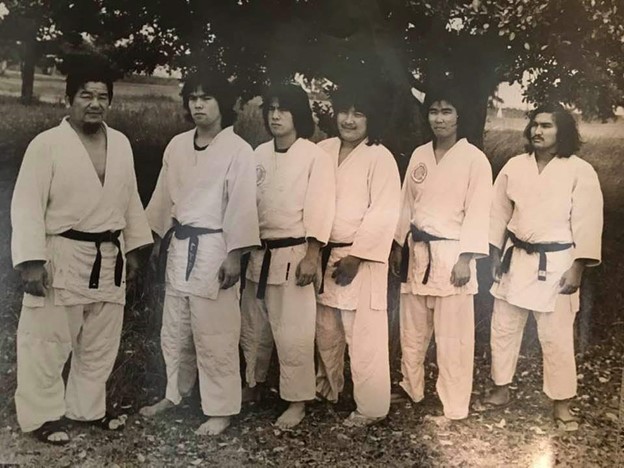
Fukushima Sensei, Keith & Burt Nakasone, Ray Dumapay, Mel Chiba, Mikey Dumapay. Yosh Nakano not present.
Keith Nakasone (born January 20, 1956, Okinawa, Japan)
Keith Nakasone has an identical twin brother named Burt, who was also a prolific athlete and judoka. They decided they didn’t want to compete against each other in college, so only Keith went to San Jose State and trained under the legendary Yosh Uchida.
Keith won 4 NCAA Championships from 1974-1977 competing for San Jose St. and 4 U.S National Championships in 1975, 1977, 1978, & 1979. He was also the captain of the 1980 U.S Olympic Judo Team. The U.S chose to boycott that Olympic and he was awarded a Congressional Gold Medal as a member of the 1980 Olympic team.
He is inarguably the best American Judoka.
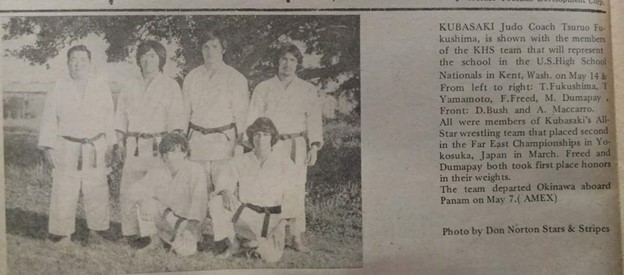
Fukushima Sensei with the 1975 KHS High School Team that went to Kent, WA.
Retirement
After he retired from the U.S. Civil Service, Mr. Fukushima moved to Oahu, Hawaii where he pursued his passion and opened the Leeward Judo Club where he was reunited with Kevin Asano, 1988 Olympic Judo Silver Medalist. His grandson, Dustin Fukushima is a sensei in Tallahassee, Florida where his father Bobby competed as a Seminole.


